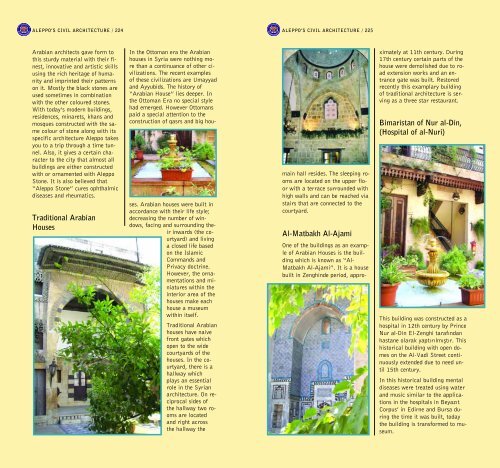You also want an ePaper? Increase the reach of your titles
YUMPU automatically turns print PDFs into web optimized ePapers that Google loves.
ALEPPO’S CIVIL ARCHITECTURE / 224 ALEPPO’S CIVIL ARCHITECTURE / 225<br />
Arabian architects gave <strong>for</strong>m to<br />
this sturdy material with their finest,<br />
innovative and artistic skills<br />
using the rich heritage of humanity<br />
and imprinted their patterns<br />
on it. Mostly the black stones are<br />
used sometimes in combination<br />
with the other coloured stones.<br />
With today’s modern buildings,<br />
residences, minarets, khans and<br />
mosques constructed with the same<br />
colour of stone along with its<br />
specific architecture Aleppo takes<br />
you to a trip through a time tunnel.<br />
Also, it gives a certain character<br />
to the city that almost all<br />
buildings are either constructed<br />
with or ornamented with Aleppo<br />
Stone. It is also believed that<br />
“Aleppo Stone” cures ophthalmic<br />
diseases and rheumatics.<br />
Traditional Arabian<br />
Houses<br />
In the Ottoman era the Arabian<br />
houses in Syria were nothing more<br />
than a continuance of other civilizations.<br />
The recent examples<br />
of these civilizations are Umayyad<br />
and Ayyubids. The history of<br />
“Arabian House” lies deeper. In<br />
the Ottoman Era no special style<br />
had emerged. However Ottomans<br />
paid a special attention to the<br />
construction of qasrs and big hou-<br />
ses. Arabian houses were built in<br />
accordance with their life style;<br />
decreasing the number of windows,<br />
facing and surrounding their<br />
inwards (the courtyard)<br />
and living<br />
a closed life based<br />
on the Islamic<br />
Commands and<br />
Privacy doctrine.<br />
However, the ornamentations<br />
and miniatures<br />
within the<br />
interior area of the<br />
houses make each<br />
house a museum<br />
within itself.<br />
Traditional Arabian<br />
houses have naive<br />
front gates which<br />
open to the wide<br />
courtyards of the<br />
houses. In the courtyard,<br />
there is a<br />
hallway which<br />
plays an essential<br />
role in the Syrian<br />
architecture. On reciprocal<br />
sides of<br />
the hallway two rooms<br />
are located<br />
and right across<br />
the hallway the<br />
main hall resides. The sleeping rooms<br />
are located on the upper floor<br />
with a terrace surrounded with<br />
high walls and can be reached via<br />
stairs that are connected to the<br />
courtyard.<br />
Al-Matbakh Al-Ajami<br />
One of the buildings as an example<br />
of Arabian Houses is the building<br />
which is known as “Al-<br />
Matbakh Al-Ajami”. It is a house<br />
built in Zenghinde period, appro-<br />
ximately at 11th century. During<br />
17th century certain parts of the<br />
house were demolished due to road<br />
extension works and an entrance<br />
gate was built. Restored<br />
recently this examplary building<br />
of traditional architecture is serving<br />
as a three star restaurant.<br />
Bimaristan of Nur al-Din,<br />
(Hospital of al-Nuri)<br />
This building was constructed as a<br />
hospital in 12th century by Prince<br />
Nur al-Din El-Zenghi taraf›ndan<br />
hastane olarak yapt›r›lm›flt›r. This<br />
historical building with open domes<br />
on the Al-Vadi Street continuously<br />
extended due to need until<br />
15th century.<br />
In this historical building mental<br />
diseases were treated using water<br />
and music similar to the applications<br />
in the hospitals in Beyaz›t<br />
Corpus’ in Edirne and Bursa during<br />
the time it was built, today<br />
the building is trans<strong>for</strong>med to museum.


